|
For Story Structure |
|
For Story Development |
|
|

|
|
|
Archetypes Characters, Narrative & Mind |
~21~
Methodology Archetypes
Before the final version of Dramatica – a New Theory of Story there was an earlier draft that contained unfinished concepts and additional theory ultimately deemed “too complex”. As a result, this material was never fully developed, was cut from the final version of the book, and has never seen the light of day — until now! Recently, a copy of this early draft surfaced in the theory archives. The following are excerpts from this “lost” text.
CAVEAT:
Because the text that follows was not fully developed, portions may be incomplete, inaccurate, or actually quite wrong.
It is presented as a look into the history of the development of Dramatica and also as a source of additional theory concepts that (with further development) may prove useful.
Introduction
This segment represents a whole new, previously unmentioned aspect of Archetypal Characters. After developing the original eight Archetypes and their Elements with Chris, based on character motivations, I went on to consider what the Archetypes might look like in terms of their Methodologies, Evaluations, and Purposes.
Theory-
Often, the original 8 Archetypes can seem limiting and lead authors into creating complex characters when, in fact, all that is really needed is another flavor of Archetypes.
This excerpt describes the first 8 of 24 new Archetypes.
Methodology Archetypes
When we began our exploration of Characters, we divided them into eight Simple Archetypes, based on their Motivations. Similarly, as we begin our exploration of Method, we discover eight Simple Methodologies that the Simple Characters employ. As before, we divide them into two quads: one reflecting Action Methodologies and the other, Decision Methodologies.
The Action Methodology Archetypes are Assertive, Passive, Responsive, and Preservative. Let’s take a look at each.
ASSERTIVE: The Assertive approach is based on the “first strike” concept. When one’s method is Assertive, she will take the initiative action to achieve her goal or obtain what she wants. .
RESPONSIVE: In Contrast, the Responsive will act only when provoked, but will then retaliate, seeking to eliminate the threat to her status quo.
PRESERVATIVE: The Preservative methodology is to build back what has been diminished and take steps to guard things against further encroachment. Unlike the Responsive Methodology, the Preservative approach will not strike back against the source of the encroachment but shield against it.
PASSIVE: The Passive approach will be to “go with the flow” and hope things get better by themselves, rather than attempting to improve them.
It is important to note that Assertive and Passive are not the Dynamic pair in this group. Rather, Assertive and Responsive complement each other. This can be seen by thinking in terms of the borders of a country. Assertive and Responsive will both cross the border, one for a first strike, the other only in retaliation. But Passive and Preservative will never cross the border, one allowing itself to be overrun, and one building defenses.
Whereas the Action Methodologies indicate the approach to manipulation of the environment that is acceptable to a given Character, the Decision Methodologies indicate the mental approach that will be acceptable. The Decision Methodologies are Dogmatic, Pragmatic, Cautious, and Risky.
DOGMATIC: The Dogmatic approach will only consider data that has been “proven” as being correct. Speculative or second-
PRAGMATIC: In opposition to that approach the Pragmatic Methodology widens their considerations to include information that may prove to be correct based on circumstantial evidence.
CAUTIOUS: When one decides in a Cautious manner, she determines the relative likelihood of various data, giving greater weight in her considerations to information that appears more certain.
RISKY: The Risky approach considers all information that is not definitely ruled out as incorrect, giving all data equal weight in the Decision process regardless of its likelihood.
In the Decision Methodologies, Dogmatic pairs with Pragmatic, and Cautious complements Risky. As a group these four Action and four Decision approaches constitute the Eight Simple Methodologies, and make up our first organization of Plot. We know these types, don’t we? They appear in our world, they appear in our stories, they appear in ourselves. They appear in our stories because they appear in ourselves. As with the Eight Simple Characters, they can be divided in Quads.
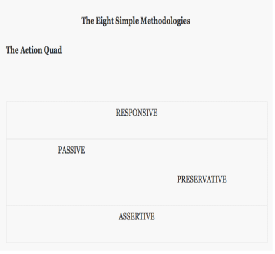
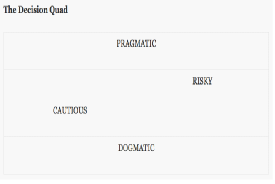
As with the Eight Simple Characters: No Character should represent more than one Methodology in a given Dynamic Pair. In other words, just as one Character should not be the Protagonist and Antagonist, one Character should not be Assertive and Responsive.
Now you may have noticed that every time we talk about the Methodologies we speak of them as the ways in which Characters act or decide. The immediate question that comes to mind is whether or not these Simple Methodologies of Plot are tied to specific Simple Characters. Let’s find out.
Archetypal Methodologies in Star Wars
Returning to Star Wars, we can analyze the Method each Simple Character employs to see if: a) they limit themselves to one, and b) if there is a match between Character Motivation and Character Method.
Certainly Obi Wan seems RESPONSIVE. He never attacks, just responds to attacks , such as the Cantina scene where he cuts off the creature’s arm after it had attacked Luke. But here the direct relationship to the motivation archetype pattern breaks down.
This time Obi is not balanced by Darth but by the Empire, which is the key ASSERTIVE Character in the story. This is exemplified in the Empire’s unprovoked attack on Leia’s home world of Alderan, and their efforts to track down and destroy the rebel base. Darth takes on a PRESERVATIVE approach, which works nicely with his charge to recover the stolen plans. Every step he takes is an attempt to get back to start. Even when he leads his fighters into the trench on the Death Star, he cautions his henchmen not to chase those who break off from the attack, but to stay on the leader.
Rounding out the Four Simple Action Methodologies, Luke fills the role of PASSIVE. Luke, Passive? Yep. When Uncle Owen tells Luke that he must stay on one more season, Luke argues, but does he accept it? When Obi tells Luke that he must go with him to Alderan, where does he end up? When the Cantina Bartender tells him the droids must stay outside, does he even argue?
Looking at the Decision Quad, Han reads very well as the DOGMATIC approach, which matches nicely with his role as Skeptic. Leia, on the other hand is clearly Pragmatic, adapting to new and unexpected situations as needed. Note the way Dogmatic Han screws up the rescue attempt in the detention block with his inability to adapt, compared to Leia blasting a hole in the corridor wall, manufacturing an escape route.
Interestingly, the joint Sidekick of R2D2 and C3PO is split by the Methodologies of RISKY and CAUTIOUS. R2D2 is always the one jumping into the fray, going out on a limb, trailblazing through blaster fire. In Contrast, C3PO doesn’t want to go into the escape pod, doesn’t want to go on R2′s “mission” to find Obi, and excels at hiding from battle whenever he gets the chance.
If we hang the Star Wars Character names on the Simple Methodology QUAD we get:
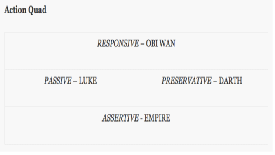
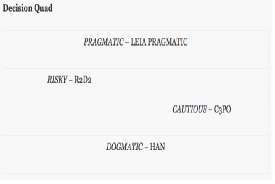
For the first time we begin to get a sense of some of the conflicts between Characters that we felt in Star Wars, but were not explained by the Motivations of the Simple Characters alone. For example, we can see that in terms of Methodology, Obi is now in direct conflict with the Empire. Suddenly the scene where he is stopped along with Luke by the Storm Troopers on the way into Mos Eisley makes much more sense, as does the scene where he must avoid the Storm Troopers and deactivate the Tractor Beam.
From the Methodology standpoint, Luke is now diametrically opposed to Darth, and that defines that additional conflict between them that does not grow from Luke as Protagonist and Darth as Contagonist. The scene in the Trench where Darth attacks Assertively and Luke ignores him with calm Passivity is a fine example of this.
The antagonism (appropriate word) between Leia and Han has a firm grounding in the Dogmatic versus Pragmatic approach. This is what gives that extra edge between them that is not created by their Simple Characters of Reason and Skeptic.
Of particular note is how R2D2 and C3PO, who share a Character role of Sidekick, are split into a conflicting Dynamic Pair of Risky and Cautious. So many of their scenes have them diverging, even while loyally following Luke. The sniping that goes on between them is a direct result of their opposing Methodologies, and enriches what otherwise would be a flat relationship. After all, if they both agreed with each other’s approach AND were jointly the Sidekick as well, how could you even tell them apart, other than by the shape of their costumes?
Finally, notice how poor Chewbacca ended up with no Methodology at all. Perhaps that explains why he never really does anything.
From the chart we can see that the opposition of Dynamic Pairs between Characters is not necessarily carried over into their Methodologies. Indeed, some Characters might be in conflict over principles but not in approach, and vice versa. This relationship between the Motivation Level and the Methodology Level is the embryonic beginning of more believable “3 dimensional” or “well rounded” Characters. To get a more clear understanding of this phenomenon, we can put the Simple Character Quads side by side with the Simple Methodology Quad.
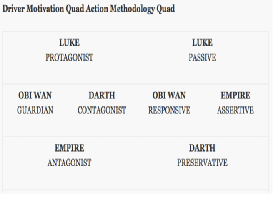
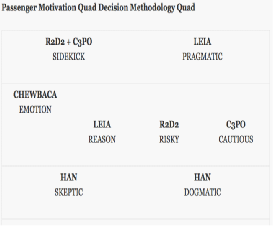
When viewed in this manner, the ebb and flow of conflict can be seen as not a single relationship between Characters, but a complex multi-
The Sixteen Methodologies
ASSERTIVE
Approach Plogistic (plot logistic):
The assertive character takes Proaction to upset a stable environment in order to achieve her goals.
Attitude Plogistic:
She Evaluates her situation to determine what action she should take.
RESPONSIVE
Approach Plogistic:
When Responsive, a character Reacts to changes in her environment.
Attitude Plogistic:
The Responsive Re-
PRESERVATIVE
Approach Plogistic:
This character employs Protection to prevent what she has from being eroded.
Attitude Plogistic:
She is driven by Non-
PASSIVE
Approach Plogistic:
The Passive character exists in Inaction, making no move to counter threats against her.
Attitude Plogistic:
SheAccepts whatever comes her way. Attitude Plogistic: She Accepts whatever comes her way.
DOGMATIC
Approach Plogistic:
Dogmatic deals only in Actualities. Approach Plogistic: Dogmatic deals only in Actualities.
Attitude Plogistic:
She relies on Deduction to reduce data to an irrefutable conclusion.
PRAGMATIC
Approach Plogistic:
The Pragmatic concerns herself with Potentialities, looking at all alternative explanations that can be created from existing data.
Attitude Plogistic:
She employs Induction to generate alternatives.
CAUTIOUS
Approach Plogistic:
The Cautious character bases her decisions on Probabilities: the most likely of alternatives.
Attitude Plotgistic:
She uses Reduction to narrow the field of conceivable alternatives.
RISKY
Approach Plogistic:
The Risky character considers all Possibilities equally, regardless of their relative likelihood.
Attitude Plogistic:
She processes information with Production to create any alternatives that are not ruled out by known data.
Placing these Plogistics in a Quad table we get:
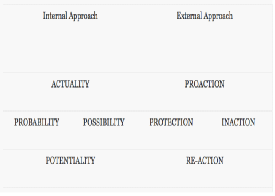
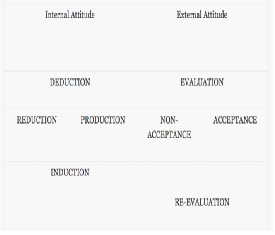
Looking at these sixteen Methodologies, it is important to remember what they represent. DRAMATICA looks at each and every element of story structure as an aspect of the Story Mind dealing with a problem. And we can clearly see that these sixteen points represent part of that process.
When examining our environment, we all make Evaluations, Re-
Once again, in stories, these Methodologies can be illustrated in individual Characters or combined in ways that do not violate their potential. The Dramatica rules for combining characteristics apply here as well.
Based upon these rules, we can easily create our own multi-
As you’ll recall, we created Joan, the Protagonist, who wants to write a screenplay. She was in conflict with the Studio Executive, our Antagonist, who wanted to sell a screenplay of her own instead. Joan’s father was a Skeptic, not believing in his daughter’s talent, but Joan’s writing teacher was her faithful Sidekick. As Contagonist, we created Joan’s friend, the Computer Whiz, who tempts Joan to use “the System”. Guardian to Joan is the Seasoned Writer, who keeps the execs of her tail and counsels her to be true to herself. The Prostitute, a student of the Classics served as Reason, and the Avant Guard Artist was Emotion.
As an exercise, let’s assign each of these Eight Simple Characters one of the Eight Simple Methodologies. As we’ve already determined, there is no requirement that a particular Methodology must be matched to a particular Character. So, if we start with Joan who is of primary importance to us, which one of the Methodologies do we like best for our Protagonist? We have a choice of Assertive, Reactive, Preservative, Passive, Dogmatic, Pragmatic, Cautious, and Risky.
Try each one against what we know of Joan. It is clear that any of the eight would create a believable and much more three dimensional Character than the simple Protagonist by herself. And yet, there will be some combinations that will appeal to one Author that are not at all acceptable to another. Protagonist Joan as an Assertive young writer, or Protagonist Joan as Risk taker? Our hero, the adamant, close-
For our tastes (where they happen to be after lunch as we write this) let’s pick a Risky Protagonist. So Joan, the “wanna-
So now, we have the rival Studio Exec, our Antagonist. And she can be any one of the seven remaining Methodologies. We could put her in direct conflict of Methodologies as well as Characteristics, by making her the Cautious type. As such, she would lay out all the ground work to assure that her script will be chosen, leaving nothing to chance. Or she could be Responsive, and attack Joan every time she sees Joan’s advancement as threatening her own. Or she could be Assertive and attack Joan without provocation, because she feels it will help her own cause. We’ll pick Assertive, because we want an Action story, and our Protagonist is not an action Character.
We continue in this manner until we have assigned a Simple Methodology to each Simple Character. So, finally, we have Risky Joan, who wants to write a screenplay and is embattled against the Assertive studio Executive who wants to stop her, opposed by her Preservationist Father, supported by her Passive Teacher, tempted by her friend, the Cautious Computer Whiz, protected by the Responsive Seasoned Writer, counseled by the Dogmatic Prostitute to copy the classics, and urged by the Pragmatic Avant Guard Artist to break new ground.
This is beginning to sound a lot less like other stories we’ve seen before. And that is just with the Simple Motivations and Methodologies. When you figure in complex Motivations and Methodologies by mixing and matching sixteen Motivations with sixteen Methodologies, then group them together in uneven ways: more to some Characters and fewer to others, you can begin to see the great variety of Characters that can be created using the DRAMATICA structure. And that is the real beauty of DRAMATICA. Because it is a system of interrelationships, a relatively small number of variables creates an astronomical number of specific structures. Form without Formula. And it works because it mirrors the structure and functioning of our own minds in the Story Mind.
Continuing along that parallel, we can see that the Story Mind in dealing with a problem will not only be motivated and apply a methodology, but will also monitor feedback to determine the effectiveness of the method and the propriety of the motivation. This function is defined by our third level of Character, Evaluation.